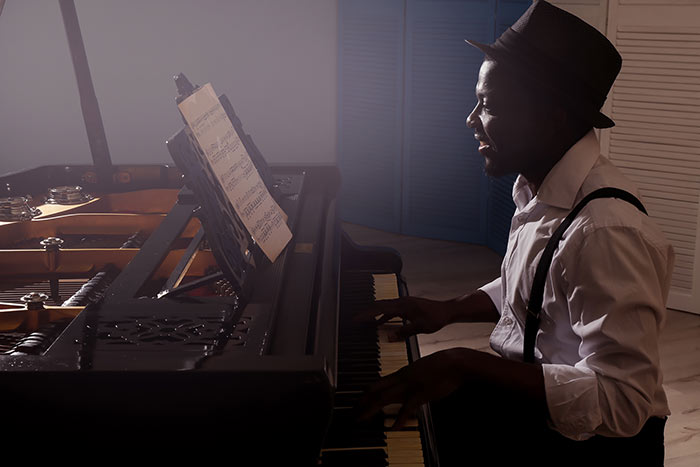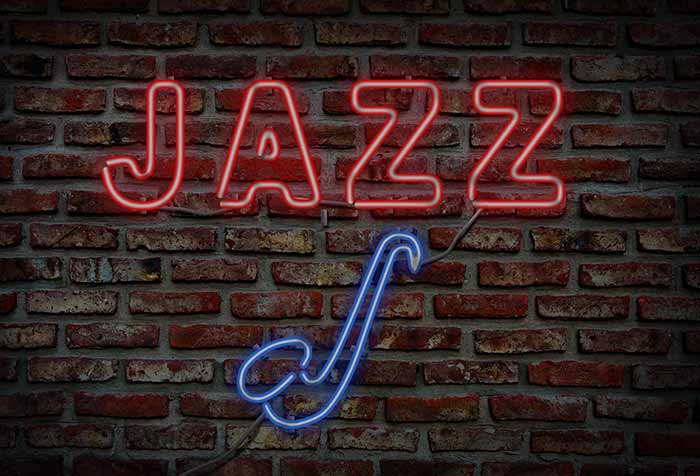What are voicings?
Voicings are created when you move the order of the basic chord tones of your jazz chord around so that an authentic jazz sound is created.
Using the normal jazz chord in its root position with its stacked 3rds on top of each other sounds boring and not like real jazz. I already discussed the building of jazz chords in the article: “Fundamental jazz chords”. It is best to change the order of the chord notes by moving them around forming not only intervals of 3rds on top of each other, but also 5ths or 7ths or 4ths or 2nds. These intervals will give a more distinct jazz sound than the normal major or minor 3rd interval which sounds move classical or sweet.
What is an interval? It’s the distance between two notes. On the piano, it’s quite clear to see. When building your chord at first, 3rds are stacked on top of each other. The interval is counted from the first note e.g. C which is counted as number 1. then count up to number 3. E will be the 3rd note. This way the interval of a 3rd is then formed. C to E forms an interval of a third. C to B will form the interval of a 7th. In this case, a major 7th. C to Bb will also form the interval of a 7th but because it has 1 less semitone, it forms a minor 7th interval.
On the piano, it’s quite clear to see tones and semitones. It’s of course very important to be able to hear the difference. Semitones are the smallest movement from one note (or sound) to another in western music. On the piano, a semitone from C-note will be the first black note to the right which will be C# or it can also be called Db. Chromatic scales are built on semitones. But let’s get back to our basic jazz voicings created between the two hands.
There are three fundamental jazz chords being the Major 7th, the Minor 7th and the Dominant 7th chords. The notes used to build the chords are derived from the scale on which the chord is built. Scale notes move consecutively starting from the 1st note up to the 8th note. The chords consist of the basic chord tones used from this 8 note scale, being tones 1 3 5 and 7. For example: If you are playing the C major 7 chords, the notes will be derived starting from the C or the C major scale. The notes for this chord will be C E G B.
Importance of the chord tones:
The Root – gives us the bass note or root of the chord and should not be omitted as it is the foundation on which the chord is built, (unless you are playing rootless chords like when playing with a band.)
The Third or 3rd – of the chord is one of the shell notes or chord tones that always has to be present as it gives us the major or minor sound and defines the chord.
The Fifth or 5th – is the 5th degree of the scale. The 5th can be omitted in chords.
The Seventh or 7th – is the tension we need to create the jazz sound with and is of absolute importance.
The only tone that can be omitted without changing the sound of your chord is the 5th of the chord. If we talk of the root, 3rd or 5th or 7th etc. – it relates to the degrees or numbered steps of the scale from where the chord is built. So the bass note of the chord is the 1st degree or note of the scale we work from.
The Root note:
When playing voicings, the root note of the chord is important in solo piano playing as it is the foundation on which the whole chord is built. If left out, the top structure may belong to another chord using the same upper chord tones but creating another chord. Playing the root gives you that bass rooting needed for the voicing you are building. The root may sometimes though be omitted, but it emphasises the quality or foundation of the harmony used.
The Guide tones or shell tones:
The next two tones or pitches found after the root or 1st tone are called the “guide tones” or “shell pitches” are the defining chord tones which really define the chord. These tones are most important for forming the character of the chord. They should not be left out (unless the jazz player so specifically desires).
The two guide tones or shell tones are 3 and 7. The 3rd determines the major or minor sound. The 7th determines if it’s a dominant 7th, or major 7th or a minor 7th chord. The minor 7 (b7) or flat 7 is used in the dominant 7th chord or minor 7th chord. It is flattened.
These two guide tones form the shell of the chord giving it its distinct character. After forming your basic chord, you can add tensions or extensions (9ths, 11ths and 13ths) to the chord to make the chord more dissonant or more “bity”.
Why voicings?
When playing jazz chords, first of all as mentioned, playing normal root position chords just built by stacking thirds on top of each other, does not really sound good. You have to move the chord tones between the hands in order to create a good jazz chord sound. In other words, playing the chord in the 1 3 5 7 position sounds quite boring. Change the order of the notes around. A better moving of the above chord tones would be for example 1 7 3 5. Let’s look at C dominant 7th as an example. Instead of playing it plainly as C E G Bb move the chord tones to form the chord in this way: C Bb E G
Extensions or tensions added to the chords
When playing jazz chords, the jazz player always wants to add extensions or tensions to the basic jazz chord so that the sound created is dissonant, rich and different to the normal classical, consonant or sweet sound or even the major and minor rock sound.
What are extensions?
Extensions are extra tones added to the already existing 1 3 5 7 chord tones. These tones are called tensions or extensions to the basic chord. It is added by once again adding 3rds on top of the basic chord structure.
After the 7th tone, you can add another interval of a 3rd which is called the 9th. then the 11th and then the 13th. These extensions can be played as normal tones or they can be flattened or sharpened. These extension tones or tensions give that tension or specific bity sounds that jazz players are looking for. You should easily be able to hear the difference when a #11 (sharp 11) is added to a major 7th chord or a b9 (flat 9) is added to a dominant 7th chord for example.
Let’s look at the C dominant 7th chord
You could add a 9 or 13 to the already existing 1 3 5 7 chords. The 9th can be flattened if desired and the 13th too, depending on the sound you want it to be. This way you as a jazz player can play around with creating sounds as far as your creativity can take you. Once again, we need a good voicing (the order of the tones) for these chords, so that it does not sound like a lot of 3rds stacked on top of each other.
Playing the chord, the bass note and melody between two hands
For the solo piano jazz player, we need to play the chords between two hands, with the bass note at the bottom with left-hand fingers, while the right-hand top fingers have to play the melody. The fingers in between plays the rest of the important chord tones which create the chord sound.
In a sense, this is no easy task and much easier for the guitarist that plays the whole chord with one hand. The question is how do I know what to play where and how?
In a sense, there is no set way of playing chords in jazz. The jazz player creates chord sounds as is pleasing to his ear. Of course, there are many basic chord structures that give us the basic jazz sound needed. There are however many variations and extensions so that you can play around with sounds and create chords to your hearts’, or rather your ears’ content. We have to start from somewhere. Here are some basics to start with.
How to create these good voicings:
There are a few basic structures to use in creating your voicings to start with. We will work with the C dominant 7 chords as our example.
The chord tones for C dominant 7 chord are
| C | E | G | Bb |
| 1 | 3 | 5 | b7 |
As was mentioned before, having the root note in place and playing the two main guide tones or shell tones (3 and 7) is our starting point.
Here are three structures to use as a start when doing your lead sheet chords.
The three structures are for voicings between the two hands. The pinky playing the bass note, the melody will be with the top right-hand fingers and the rest of the voicing will be filled in with the rest of the hand. We need a basic structure to work from to create the chord structure on which the melody will be played or you will be improvising. Here are 3 structures to use in your development of a voicing.
Structure number 1: playing root and 7 with the left hand
As already mentioned it is extremely important to play the root note plus the 2 guide tones or shell notes or which is 3 and 7. In our first structure, we will be playing Root and 7 with the left hand (LH) and adding the rest of the notes with the right hand (RH). It means you will be playing the C dominant 7 chord as follows:
| Left Hand | Right Hand |
| 1 and 7 C and Bb |
3 (5 optional) plus extensions E (G) |
Practise this structure in all your keys. It would be best to play it using the circle of 5ths. This means you will be playing the C dominant 7th chord as shown above. Then count down 5 notes bringing you to F. Play the F dominant 7th chord using the same structure of Root and 7 in the left hand, and 3 in the RH.
Once again countdown 5 notes which will bring you to Bb. Play the Bb dominant 7th chord using the same structure. The ideal is that you practise all the dominant 7th chords with the given structure in the circle of 5ths so that each chord will be familiar to you. It’s important to be able to see and know where the Root and the 7th and the 3rd tone of each chord lies. It could take you quite some time to conquer this, but it is well worth it.
Here is the circle of 5ths for your reference: We start on C then count up 5 notes each time to find the next key or notes to play on. Use the given circle of 5ths to play your all dominant 7ths on each note. This means that you will have to know how each dominant 7th looks built on each of these notes. Knowing the chords built on each note can be found on google. See Wikipedia for a Dominant 7th Chord Table.
“In music theory, a dominant seventh chord, or major-minor seventh chord, is a seventh chord, usually built on the fifth degree of the major scale, and composed of a root, major third, perfect fifth, and minor seventh. Thus it is a major triad together with a minor seventh, denoted by the letter name of the chord root and a superscript “7”. An example is the dominant seventh chord built on G, written as G7, having pitches G–B–D–F”
Use the Circle of fifths to play your dominant 7ths on:
| Circle of fifths | Circle of fourths |
| C G D A E B F# C# (Sharp keys) | C F Bb Eb Ab Db Gb Cb (Flat keys) |
The next structure to practise is the close interval of a 3rd in the left hand.
Structure number 2: playing root and 3 with the left hand
Here the root and the 3 is played by the left hand and the rest of the chord tones are played by the right hand.
This structure is used not lower than C3 (the C below middle C) else the sound becomes muddy.
| Left Hand | Right Hand |
| 1 and 3 C and E |
7 plus extensions Bb |
The 7th is played with the right hand and extensions can be added as desired.
In this structure, the Root and 3rd are very close to one another and this structure will not work too low down on the keyboard, as the sound will be too muddy and not clear. This structure is best suited for chords from D under middle C and up. Once again practise this structure through the circle of 5ths.
Structure number 3: playing root and 10th – (the 3 above the octave) with the left hand
In this structure the root is played and the 3 of the chord, (guide tone), but Not the 3 which is a third away from the root. It’s played as a tenth. It might be that you can not reach the 10th interval in which case the root is played with the pinky and then you jump to the 3rd tone with your thumb. Some players can stretch to play a 10th interval but for most players, a jump is needed. The RH once again plays the 7 plus other extensions and the 5th may also be added if a thicker sound is desired. Example: C dominant 7
| Left Hand | Right Hand |
| 1 and 10 (3) C and E |
7 plus extensions Bb |
Once again practice your dominant 7th chord starting on C using the circle of 5ths.
Practise your major 7ths and minor 7ths as well so that you can have a clear understanding of each chord and their particular notes and the pattern or picture it forms. This will help you when having to play in future.
I find it easier to learn chord pictures or chord voicings by doing a jazz standard like Autumn Leaves. The song consists of 7 basic chords plus 2 chromatic chords. List the chords and then work out the usable voicings built on the 3 structures given above.
There are another two structures which can be used in your jazz chord playing called “rootless chords” and “stride piano”. These will be addressed in the next article.
How to practise and develop voicings:
- I suggest that you practise all your major 7th chords, all your minor 7th chords and all the dominant 7th chords in the three basic structures given.
- Start with structure Nr 1 and practise all the dominant 7 chords throughout the circle of 5ths, using the very basic chord notes. First familiarize yourself with these basic chord tones 1 b7 3 and 5 and their positions before adding tension, unless it’s forming an easy picture for you on the keys.
- After the dominant 7th chords, do all the major 7ths and so forth.
- Work also through structure 2 and 3 throughout the circle of 5ths with the different chords.
- Try to visualise the picture which is formed with each chord, so that you will be able to “see” the next chord in the circle of 5ths.
- Knowing where the guide tones or shell tones – 3 and 7 of each chord lies, is vital.
- After knowing the basic chord voicings, start to add extensions as your ear leads you. Having the basic structures gives you enough room to start to experiment with adding tensions and broadening chords and sounds.
- Working through the basics will take some time, but it is well worth it.
- In the next article, we will be looking at the three structures in voicings for Autumn Leaves as well as extensions of your chords.




![Man playing piano while the other man watches-] him feat](https://www.londonpianoinstitute.co.uk/wp-content/uploads/2024/02/man-playing-piano-while-the-other-man-watches-him_feat.jpg)


